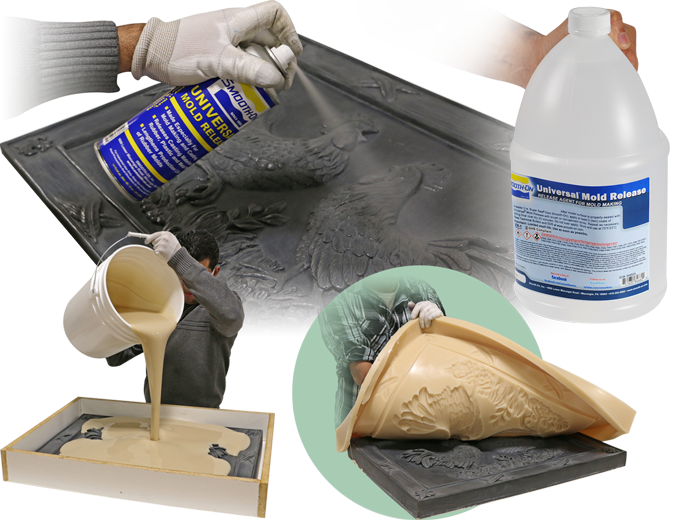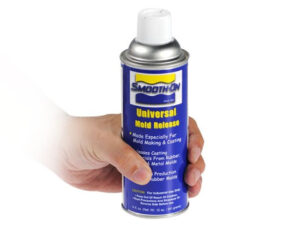Are you fed up with stubborn residues, difficult demolding, and time wasted in your polyurethane (PU) molding procedures?
Optimizing production efficiency and product quality relies on selecting the ideal mold release agent. It facilitates effortless demolding, minimizes manufacturing expenses, and aligns with your needs. But, with a plethora of options flooding the market, selecting the right mold release agent can feel overwhelming.
Worry not. We are here to help you streamline and empower your decision-making process. This all-inclusive guide will demystify the selection of a suitable PU mold release agent for you, providing invaluable insights into crucial considerations. With this knowledge, you can make informed decisions and optimize your molding operations effectively.
So, are you ready to revolutionize your PU molding experience? Let’s get started!
PU Mold Release Agents
Mold-release agents are specially formulated substances that enable the smooth removal of polyurethane (PU) parts from molds. They effectively prevent sticking and guarantee a hassle-free release by creating a protective layer on the mold surface.
The Function Of Mold Release Agents
PU mold release agents play a crucial role in maintaining the integrity and quality of molded parts while optimizing production efficiency. By minimizing the risk of sticking or tearing during demolding, these agents safeguard the shape, surface finish, and dimensional accuracy of the final PU products.
Common Types Of PU Mold Release Agents
1. Solvent-Based Release Agents
Solvent-based release agents, formulated with evaporative solvents, create a thin film on the mold surface. They provide outstanding release properties and versatility for various PU applications. Rapid drying time and compatibility with different mold materials make them preferred choices. But, they may contain volatile organic compounds (VOCs) and need proper ventilation during application.
2. Water-Based Release Agents
Water-based release agents, primarily comprised of water, additives, and emulsifiers, offer a safer and eco-friendly alternative to solvent-based agents. With favorable release properties, low odor, and easy application, they are commonly used in VOC reduction-focused PU molding processes. But, they may require longer drying times than solvent-based options.
3. Hybrid Release Agents
Bringing the best of both above, Hybrid release agents combine the advantages of solvent-based and water-based formulations. While reducing environmental impact, it improves release performance and durability. These agents offer versatility while effectively balancing effectiveness and sustainability.
Pros and Cons Of Each Type Of Release Agent
| Type of PU Mold Release Agent | Pros | Cons |
| Solvent-based release agents | Excellent release properties | Potential VOC emissions |
| Quick drying time | ||
| Requires proper ventilation during application | ||
| Compatible with various mold materials | ||
| Water-based release agents | Safer and environmentally friendly | Longer drying time compared to solvent-based agents |
| Low odor | ||
| Easy application | ||
| Hybrid release agents | Enhanced release performance | May cost more than other types |
| Improved durability | ||
| Reduced environmental impact |
Factors To Consider When Choosing A Pu Mold Release Agent
Selecting the perfect PU mold release agent necessitates a thorough evaluation of key factors. Let’s delve into these factors comprehensively.
1. Compatibility with Polyurethane Materials
Ensure the selected mold release agent is designed and formulated for polyurethane materials. Different PU formulations may have varying chemical compositions and properties, so choosing a release agent compatible with the specific type of polyurethane is essential. Compatibility ensures optimal performance and avoids any adverse reactions that could impact the quality of the molded parts.
2. Mold Complexity and Design
The complexity and design influence the effectiveness of the mold release agent. Take into account the intricacy of the mold, including its details, corners, and undercuts. For molds with complex geometries, opt for a release agent that can effectively reach all areas, ensuring thorough coverage and dependable release performance. An ideal release agent for molds with intricate designs should provide excellent coverage and the ability to penetrate tight spaces.
3. Desired Release Performance
The desired release performance varies based on the application and molded part requirements. Consider the level of release needed, whether it’s easy demolding for intricate or delicate parts or achieving smooth and flawless surface finishes. Some applications may require a mold release agent with enhanced performance, such as high-temperature resistance for demanding molding processes or special additives for improved release in challenging conditions.
4. Environmental and Health Considerations
Environmental and health concerns have also become crucial in selecting a proper PU mold release agent. Prioritize release agents with low or no volatile organic compound (VOC) content to recede the environmental impact and promote a healthier workplace. Additionally, consider any specific regulations or guidelines governing the use of certain chemicals in your region.
5. Ease of Application and Cleanup
The application and cleanup process significantly impact production efficiency and convenience. Opt for a mold release agent that is easy to apply, like through spraying, brushing, or wiping techniques. Consider factors like drying time, reapplication frequency, and the ease of removing any residual release agent after demolding. Choosing a release agent that simplifies the application process and minimizes cleanup time can streamline your production operations effectively.
7. Cost and Budget
Budget considerations are also the most vital in release agent selection. Evaluate the cost-effectiveness of various options, considering the value they provide. While cost is a factor, it should be balanced against the benefits and performance of the mold release agent. Investing in a reliable and effective mold release agent can improve productivity, reduce scrap rates, and enhance product quality.
8. Other Factors
Consider other application-specific factors, including the intended use of the molded parts and specific surface finish requirements. Some mold release agents may be better suitable for automotive, medical, consumer goods, or related applications. Consider the desired surface finish, whether glossy, matte, textured, or other specific characteristics. Some release agents may offer additional features, such as mold conditioning properties or anti-static benefits, which can be advantageous for particular applications.
How to Assess The Mold Release Agent Performance?
Performance evaluation is crucial when selecting a PU mold release agent. Consider factors affecting the molding process and part quality. Key aspects to assess include the following.
1. Release Efficiency
A mold release agent should facilitate easy part removal from the mold as its primary function. Assess the release efficiency of the agent by evaluating how effectively it prevents adhesion between the PU material and the mold surface. A good release agent should enable smooth and effortless demolding without causing damage or distortion to the parts or the mold.
2. Impact On Surface Finish
The release agent should not negatively affect the desired surface finish of the molded parts. Check how the release agent interacts with the PU material to ensure it does not leave residue, marks, or alter the appearance of the components. The agent should provide consistent surface quality, preserving the intended texture, gloss, or matte finish.
3. Durability And Longevity
Consider the durability and longevity of the release agent’s performance. It should offer consistent release properties over multiple demolding cycles, eliminating the need for frequent reapplication. A durable release agent minimizes downtime and reduces the risk of defects caused by inadequate release performance.
4. Compatibility With Secondary Processes
If the molded parts have to undergo secondary processes such as painting or bonding, ensure compatibility of the release agent with these processes. Some release agents may leave residues or contaminants, impeding adhesion and compromising the quality of subsequent treatments. Verify the chosen release agent does not hinder the performance of secondary processes.
5. Potential Drawbacks And Limitations
Finally, consider any potential drawbacks or limitations associated with the release agent. For instance, mold release agents may need longer drying times, have temperature restrictions, or exhibit reduced performance when exposed to specific chemicals or extreme conditions. Identifying such limitations enables you to make informed decisions and proactively address potential challenges.
How To Test And Evaluate The Performance Of A Pu Mold Release Agent?
Conduct small-scale tests or trial runs to assess PU mold release agent performance.
- Apply the mold release agent to a sample mold and observe the demolding process.
- Assess the ease of part removal, surface quality, and any residue left behind.
- Compare the performance of different release agents to determine which meets your requirements effectively.
- Also, consider gathering feedback from operators and production teams who work with the release agent. Their observations and experiences can provide valuable insights into its performance and any practical considerations.
Testing and gathering feedback ensure it meets expectations and contributes to molding success.
Steps to Select The Right Pu Mold Release Agent
After considering the factors mentioned earlier, follow these steps to make the best decision.
1. Researching And Evaluating Options
- Conduct thorough market research on PU mold release agents.
- Seek renowned suppliers, manufacturers, and distributors specialized in polyurethane mold release agents.
- Analyze their product range, specifications, and relevant details.
2. Testing And Trial Runs
- Conduct rigorous testing and trial runs using the chosen release agents to evaluate their performance in your unique molding process.
- Apply each agent to sample molds and assess crucial factors like release efficiency, surface finish, demolding ease, and compatibility with secondary processes.
Conduct these tests under realistic production conditions to ensure accurate and reliable results.
3. Consulting With Industry Experts Or Suppliers
Finally, we recommend consulting industry experts like Yiijn Hardware with deep knowledge of mold release agents. They can offer valuable guidance, suggest appropriate options tailored to your needs, and address inquiries or doubts. Their expertise will streamline your selection process, ensuring you consider the most suitable choices for your application.
Conclusion
A well-chosen PU mold release agent streamlines production, enhances product quality, and boosts productivity in your PU molding processes.
This comprehensive guide has explored the critical considerations for choosing the superior PU mold release agent for your requirements.
Use the insights from this guide and take time to evaluate and select the ideal PU mold release agent to optimize your polyurethane molding operations and reap its rewards in simplified processes and manufacturing success.


